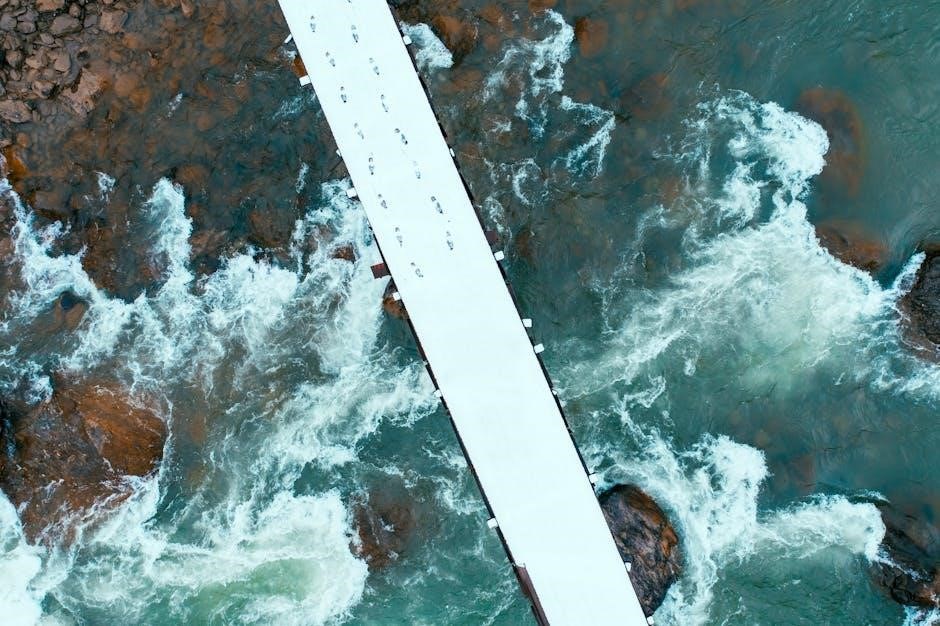A waveguide cover is a protective component designed to shield waveguides from environmental factors, ensuring optimal signal transmission and maintaining performance across various frequencies.
What is a Waveguide?
A waveguide is a specialized structure designed to direct and transmit electromagnetic waves, such as microwaves or radio waves, with minimal loss of energy. It operates by confining the electromagnetic fields within its boundaries, allowing the waves to propagate efficiently through the structure. Commonly used in microwave engineering and telecommunications, waveguides are essential for maintaining signal integrity over long distances. They are typically constructed from conductive materials, which help in reflecting the waves and preventing leakage. The design of a waveguide ensures that the waves are guided through a specific path, making it a critical component in systems requiring precise signal transmission. Waveguides are widely used in applications such as radar systems, satellite communications, and high-frequency antennas, where reliable signal propagation is paramount. Their ability to handle high-frequency signals makes them indispensable in modern communication technologies.
What is a Waveguide Cover?
A waveguide cover is a protective accessory designed to encase waveguides, preventing environmental interference and ensuring optimal performance. It shields the waveguide from dust, moisture, and other external factors that could degrade signal quality. Typically made from durable materials such as metal or high-performance plastics, the cover is precision-engineered to fit snugly over the waveguide, maintaining its structural integrity. The cover plays a crucial role in preserving the waveguide’s ability to transmit electromagnetic waves efficiently, especially in harsh operating conditions. By minimizing external influences, it helps maintain consistent signal transmission and prevents signal loss. The waveguide cover is an essential component in systems requiring high reliability and precision, such as radar, telecommunications, and microwave engineering applications.
Importance of Waveguide Covers
Waveguide covers are essential for protecting waveguides from environmental factors that could compromise their performance. They prevent dust, moisture, and other contaminants from interfering with the transmission of electromagnetic waves, ensuring signal integrity. By shielding the waveguide, the cover minimizes signal loss and maintains consistent transmission across the desired frequency range. This is particularly critical in high-frequency applications where even minor interference can lead to significant performance degradation. Additionally, waveguide covers enhance durability, protecting the waveguide from physical damage and extending its operational lifespan. In industrial and telecommunications settings, where reliability is paramount, waveguide covers play a vital role in maintaining system efficiency and preventing downtime. Their use ensures optimal functionality in demanding environments, making them a crucial component in modern communication and radar systems.

Design and Construction
Waveguide covers are precision-engineered using advanced manufacturing techniques to ensure optimal fit and performance, designed to facilitate efficient electromagnetic wave transmission while maintaining structural integrity.
Materials Used
The selection of materials for waveguide covers is critical to ensure optimal performance. Commonly used materials include aluminum, copper, and high-performance plastics, chosen for their excellent electrical conductivity and durability.
Manufacturing Process

The manufacturing of waveguide covers involves precise engineering to ensure optimal performance. Common techniques include CNC machining and 3D printing, which provide high accuracy and customization. The process begins with material selection, followed by cutting and shaping to meet specific dimensional requirements. Finishing steps, such as anodizing or plating, may be applied to enhance durability and electrical conductivity. Quality control measures, including dimensional inspections and electrical performance testing, are implemented to ensure compliance with industry standards. Advanced manufacturing methods allow for the production of complex geometries, catering to diverse applications in telecommunications and radar systems. Each step is carefully optimized to maintain the integrity and functionality of the waveguide cover, ensuring reliable operation across various frequency ranges.
Structural Components
The structural components of a waveguide cover are essential for its functionality and durability. Key elements include the base plate, which provides a stable mounting surface, and the cover itself, designed to fit snugly over the waveguide. Alignment features, such as guide pins or screws, ensure proper positioning to maintain signal integrity. Sealing mechanisms, like gaskets or O-rings, prevent environmental contaminants from affecting the waveguide. Reinforcement elements, such as ribs or brackets, enhance structural rigidity, particularly in high-stress or vibration-prone environments. These components work together to protect the waveguide while allowing for easy access during maintenance. The design and material selection of these parts are critical to ensure the cover meets the required mechanical and electrical specifications for various applications.

Applications
Waveguide covers are essential in microwave engineering, telecommunications, and radar systems, ensuring signal integrity and protection in high-frequency applications.
Microwave Engineering
In microwave engineering, waveguide covers play a critical role in protecting waveguides from dust and moisture, ensuring minimal signal loss and optimal performance. These covers are designed to maintain the structural integrity of waveguides, which are essential for transmitting microwave energy at high frequencies. By preventing contamination, waveguide covers help sustain the purity of microwave signals, which is crucial for applications like satellite communication, radar systems, and microwave ovens. The materials used for these covers are typically non-conductive and durable, ensuring they do not interfere with the electromagnetic fields within the waveguide. Proper installation and maintenance of waveguide covers are vital to uphold the efficiency and reliability of microwave systems. Their role is indispensable in maintaining the overall performance and longevity of microwave engineering equipment.
Telecommunications
In telecommunications, waveguide covers are essential for protecting waveguides from environmental factors that could degrade signal quality. These covers prevent dust, moisture, and other contaminants from interfering with the transmission of microwave signals, which are critical for high-speed data transfer. In systems such as satellite communication and fiber optic networks, waveguide covers ensure reliable signal propagation, minimizing attenuation and signal loss. They are particularly vital in outdoor installations, where harsh weather conditions can compromise waveguide performance. By maintaining the integrity of the waveguide, these covers help ensure consistent and high-quality data transmission, which is indispensable for modern communication systems. Their role in telecommunications underscores their importance in supporting the infrastructure that enables global connectivity and information exchange.

Radar Systems
In radar systems, waveguide covers play a critical role in maintaining the integrity and performance of waveguides used for transmitting and receiving high-frequency signals. These covers protect the waveguides from environmental contaminants such as dust, moisture, and debris, which could otherwise interfere with signal propagation and degrade system accuracy. Radar systems rely on precise signal transmission to detect and track targets effectively, making the reliability of waveguides paramount. By shielding the waveguides, covers ensure consistent and uninterrupted operation, even in harsh or dynamic environments. This is particularly important in applications like air traffic control, weather monitoring, and military surveillance, where radar accuracy and reliability are mission-critical. The use of durable, high-quality materials in waveguide covers further enhances their effectiveness in supporting radar system performance;

Performance Characteristics
Waveguide covers are engineered to optimize signal transmission, minimize losses, and ensure impedance matching across specified frequency ranges, enhancing overall system efficiency and reliability in various applications.
Frequency Range
The frequency range of a waveguide cover is a critical factor in its performance, determining the range of electromagnetic frequencies it can effectively transmit or shield. Typically, waveguide covers are designed to operate within specific frequency bands, such as microwave or millimeter-wave frequencies, ensuring minimal signal attenuation and maximum efficiency. The frequency range is influenced by the physical dimensions of the waveguide and the materials used in the cover. Proper design ensures that the cover allows signals within the desired frequency range to pass through while blocking unwanted frequencies that could cause interference. For applications requiring broader bandwidth, specialized waveguide covers with extended frequency ranges are available, offering flexibility for diverse operational needs. Accurate matching of the frequency range to the application is essential for optimal performance and reliability in systems. This ensures seamless signal transmission and minimizes potential disruptions.
Impedance Matching
Impedance matching is a vital aspect of waveguide cover design, ensuring that the waveguide system operates efficiently by minimizing signal reflections. Proper impedance matching guarantees that the electromagnetic waves are transmitted smoothly, without losing energy due to mismatched impedances. The cover must be designed to maintain the characteristic impedance of the waveguide, typically 50 ohms for many systems, to prevent signal degradation. Advanced materials and manufacturing techniques are employed to achieve precise impedance matching, ensuring compatibility across the entire frequency range. Improper matching can lead to standing waves, increased insertion loss, and reduced system performance. Therefore, careful consideration of impedance matching is essential during the design and installation of waveguide covers to maintain optimal signal integrity and overall system efficiency.

Insertion Loss
Insertion loss refers to the attenuation of signal strength as it passes through a waveguide system, including the cover. It is measured in decibels (dB) and indicates the reduction in power due to the introduction of the cover. Factors such as material properties, surface finish, and design tolerances significantly influence insertion loss. High-quality waveguide covers are designed to minimize this loss, ensuring that the signal remains strong and intact. Excessive insertion loss can degrade system performance, leading to poor signal quality and reduced operational efficiency. Therefore, careful material selection and precise manufacturing are critical to maintaining low insertion loss while safeguarding the waveguide from environmental interference. Regular maintenance and inspections are also essential to prevent degradation over time, ensuring optimal signal transmission.

Challenges and Limitations
Waveguide covers face challenges such as frequency limitations, material constraints, and thermal management issues, which can affect performance and reliability in high-frequency applications.
Frequency Limitations
Waveguide covers are typically designed to operate within specific frequency ranges, beyond which their effectiveness diminishes. At higher frequencies, signal attenuation increases, reducing the cover’s ability to maintain optimal performance. Additionally, mismatched frequency ranges can lead to impedance issues, further degrading signal quality. These limitations necessitate careful selection and tuning of waveguide covers to ensure they align with the intended application’s frequency requirements. Proper design and material choice are critical to mitigating these constraints and ensuring reliable operation across the desired bandwidth. Without addressing these frequency limitations, waveguide covers may fail to provide the necessary protection and performance, leading to suboptimal system functionality.
Material Constraints
The choice of materials for waveguide covers is critical but often limited by factors such as conductivity, durability, and cost. Metals like aluminum and copper are commonly used due to their high conductivity, but they may not always be suitable for extreme environments. Plastics and composites offer corrosion resistance but may lack the necessary thermal stability. Material thickness also plays a role, as overly thick materials can introduce signal loss, while too thin materials may compromise structural integrity. Additionally, materials must be compatible with the waveguide’s operating frequency to avoid impedance mismatches. These constraints require a balanced approach to material selection, ensuring optimal performance while addressing practical limitations. Improper material choices can lead to degraded signal quality and reduced lifespan of the waveguide system.
Thermal Management Issues
Thermal management is a significant challenge in waveguide cover design, as temperature fluctuations can alter electrical properties and degrade performance. Heat generated from high-frequency signals or environmental exposure can cause dimensional changes, leading to misalignment and impedance mismatches. Additionally, uneven heat distribution can induce stresses, potentially causing warping or cracking of the cover. Advanced materials with high thermal conductivity are often used to mitigate these effects, but they may introduce additional costs. Effective cooling mechanisms, such as heat sinks or ventilation systems, are essential to maintain stable operating conditions. Failure to address thermal issues can result in reduced system reliability and lifespan, emphasizing the need for robust thermal management strategies in waveguide cover applications.

Installation and Maintenance
Proper installation of waveguide covers requires precise alignment and secure tightening to ensure optimal performance. Regular maintenance involves cleaning, inspecting for damage, and verifying tightness. Handling with care is essential to prevent scratches or dents, while environmental factors like humidity and temperature must be monitored to avoid degradation. Schedules for inspection and replacement should be adhered to, following manufacturer guidelines to maintain reliability and efficiency in operation.
Installation Best Practices
Installing waveguide covers requires adherence to specific guidelines to ensure optimal performance and longevity. Begin by preparing the waveguide surface, ensuring it is clean and free from debris. Next, align the cover precisely with the waveguide’s mounting points to prevent misalignment, which can lead to signal interference. Use the recommended torque specifications when tightening fasteners to avoid over-tightening, which may damage the cover or the waveguide itself. Environmental conditions, such as temperature and humidity, should be monitored during installation to prevent moisture accumulation or thermal expansion issues. Finally, conduct a post-installation inspection to verify the cover’s integrity and ensure all connections are secure. Following these best practices helps maintain signal integrity and extends the lifespan of the waveguide system.
Maintenance Requirements
Regular maintenance of waveguide covers is essential to ensure their effectiveness and longevity. Begin by inspecting the covers for signs of wear, such as dents, scratches, or corrosion, which can compromise their protective function. Clean the covers periodically using approved cleaning agents to remove dirt and contaminants that may interfere with signal transmission. Check the sealing gaskets for integrity, ensuring they remain tight to prevent moisture ingress. Additionally, verify that all fasteners are securely tightened to the manufacturer’s specifications to maintain a proper seal. In harsh environments, consider applying a protective coating to shield against extreme temperatures or chemicals. Schedule routine maintenance intervals based on operational conditions to address potential issues before they escalate. Proper upkeep not only preserves the waveguide’s performance but also prevents costly repairs and downtime.

Safety Considerations
Handling waveguide covers requires careful attention to avoid damage and ensure safe installation. Wear protective gear, including gloves and eyewear, to prevent injuries from sharp edges or debris.
Handling Precautions
When handling waveguide covers, it is essential to wear protective gear such as gloves and eyewear to prevent injuries from sharp edges or debris. Avoid touching sensitive surfaces to prevent contamination and ensure proper electrical insulation. Use approved tools and follow manufacturer guidelines to avoid damaging the cover or the waveguide itself. Proper lifting techniques should be employed to prevent strain injuries, especially with heavier covers. Additionally, ensure the environment is static-free to prevent damage to sensitive components. Regular inspection of the cover for signs of wear or damage is crucial before installation or use. Always refer to the manufacturer’s safety manual for specific handling instructions to maintain both personal safety and component integrity.
Environmental Factors
Waveguide covers must be designed to withstand various environmental factors that could impact their performance. Dust, moisture, and extreme temperatures are primary concerns, as they can degrade the cover’s materials and compromise the waveguide’s functionality. Humidity and temperature fluctuations can cause expansion or contraction of the cover, potentially leading to structural issues. Additionally, exposure to harsh chemicals or corrosive substances can erode the cover’s surface, reducing its effectiveness. UV exposure from sunlight can also degrade certain materials over time, especially in outdoor applications. To mitigate these risks, waveguide covers are often constructed from durable, weather-resistant materials and may include additional protective coatings. Regular maintenance, such as cleaning and inspections, is essential to ensure the cover remains intact and functions optimally in its operating environment.
Waveguide covers play a crucial role in protecting waveguides from environmental factors, ensuring optimal performance by maintaining signal integrity and efficiency across diverse applications.
Future Trends in Waveguide Cover Technology
Advancements in waveguide cover technology are expected to focus on high-frequency applications and miniaturization. Researchers are exploring new materials like graphene and metamaterials for enhanced thermal management and wider frequency ranges. Additionally, 3D printing is being adopted for customizable designs, enabling faster production and reduced costs. The integration of smart materials that adapt to environmental changes is also on the horizon. Furthermore, 5G and quantum communication systems are driving demand for low-loss and high-isolation waveguide covers. Finally, sustainable manufacturing practices are expected to play a key role in future designs, ensuring eco-friendly solutions without compromising performance. These innovations will ensure waveguide covers remain critical in advancing modern communication and radar systems.
